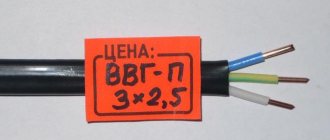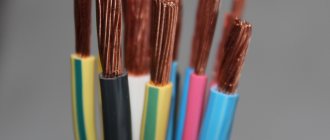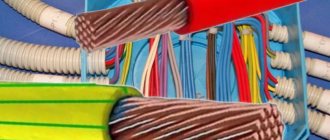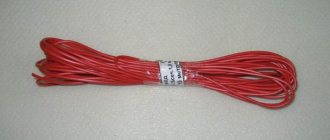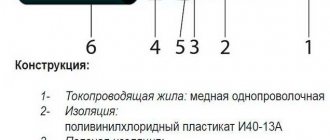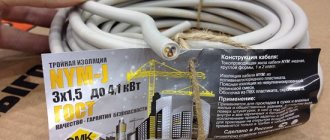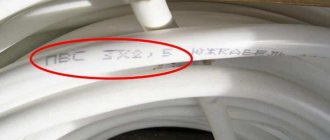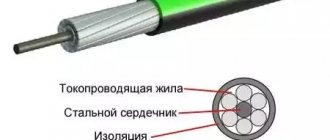In lighting and power networks, SIP brands are used, which stands for self-supporting insulated wire. They are connected to the supports of overhead lines that transmit electricity from transformer substations and distribute it to consumers. There are several modifications of these conductors for different rated voltages.
Conductor SIP 3
How is SIP-3 wire deciphered?
The decoding of the SIP cable is as follows:
- C – indicates that the product is self-supporting;
- And - means that there is an insulating layer around the cores;
- P - indicates that the product is a wire.
What does SIP 3 look like?
For example, you can take this name, SIP1 2×20+1×30-0.4, where SIP-1 indicates the model of the insulated wire, 2×20 means that the design has two cores with a cross-section of 20 mm square each, 1×25 indicates that the neutral wire will have a cross-section of 30 mm2, 0.6 is the permissible voltage for this wire.
Depending on the cable model, they can be divided into five groups, each of which is assigned a number from 1 to 5.
Important! At the end of the marking a symbol may be added indicating design features and operational properties.
SIP wire 3 technical characteristics
Structural and electrical parameters
| Number and cross-section of cores, pcs. x sq.mm | Estimated weight, kg/km | Diameter, mm | Permissible current load, A | One-second short circuit current, kA | |
| with aluminum alloy core | with aluminum core, reinforced with steel wire | ||||
| 1x35 | 168,6 | 202,0 | 11,5 | 200 | 3,2 |
| 1x50 | 219,8 | 262,9 | 12,6 | 245 | 4,3 |
| 1x70 | 287,5 | 350,2 | 14,3 | 310 | 6,4 |
| 1x95 | 369,4 | 456,2 | 16,0 | 370 | 8,6 |
| 1x120 | 450,4 | — | 17,4 | 430 | 11,0 |
| 1x150 | 544,3 | — | 18,8 | 485 | 13,5 |
Technical parameters of SIP-3 cable
The wire functions perfectly in any weather and in hazardous environments, and is resistant to mechanical and chemical damage. Basically, the cores are made of durable aluminum wire with stable mechanical parameters along the entire length. Main technical characteristics:
- The wire can heat up to 80 degrees; when overloaded, this temperature reaches 150. Critical indicators at which a short circuit occurs are from 200 degrees;
- The inner insulating layer of the wire is made of fire-resistant, sun-resistant polyethylene;
- Permissible temperature range from -50 to 70 degrees. Thanks to the insulating layer, the cable can be used in fairly aggressive outdoor environments, in industrial areas, tropics, etc.;
High voltage cable
- The insulating shell is resistant to moisture. But in areas with high humidity it is necessary to use sealed protection for the wire;
- Cable laying on supports, their connection and wiring of linear branches to them is carried out using special fittings for SIP products, which ensures the tightness of all boundaries.
You might be interested in this All about the KVVG cable
Exploitation
You cannot start operating the line without preliminary testing. The same event should be carried out a year after the launch of overhead lines with SIPs, as well as after repairs. In other cases, they look at the situation and take into account the climate.
If during operation of an overhead line an uneven (asymmetrical) load distribution is detected on it, measurements are taken on the most loaded phase. This is done once a year with the indicators entered in the line passport.
Note! In the event that the insulated wire is damaged, the defective core is dismantled. For this purpose, special wedges are used and do not relieve tension from the line.
The same applies to the branch to a residential building if the damage is no more than 20%. Otherwise, the voltage will have to be turned off. The house itself is de-energized in any situation.
After dismantling, 2 layers of special glue are applied to the damaged core. After it dries, the core is mounted in its place. This method of repair is beneficial both in terms of cost savings and in the brevity of repair work, which SIPs allow to carry out without disconnecting the line.
Scope of application of SIP-3
The wire is used when laying overhead power lines. The product moves and distributes electricity between consumers; the DC characteristics in the network must correspond to 20 kV (35 kV maximum), 50 Hz.
The cable can be laid in areas with a temperate, cold and humid climate, in industrial and coastal areas (sea coast, lakes).
Traverse on overhead line support
The cable of the SIP-3 model can be laid in urban and rural areas, in uninhabited areas where wiring of highways of considerable length is required with minimal power losses.
Important! The wire can be laid in the air on high enough supports, which allows it to be installed above residential buildings.
Advantages of SIP
- With equal capital investments, power lines with self-supporting insulated wires require lower operating costs;
- Reducing the width of clearings to be cut down during the construction of power lines in forest areas;
- Possibility of joint suspension on supports of wires with different voltage levels and with telephone lines;
- The possibility of installing power lines along the facades of buildings, which can eliminate the installation of some of the supports that clutter the sidewalks, it is possible to lay a completely or partially hidden network, making it easier to connect branches to buildings;
- Reducing safe distances to buildings and other engineering structures (electrical, telephone, overhead lines);
- Height above ground level - 4 meters, for bare wires - 6 meters;
- The possibility of a short circuit between phase wires or to ground is excluded;
- Eliminating the risk of fires if wires fall to the ground;
- High service safety - no risk of injury when touching live phase wires;
- Less weight and longer duration of snow sticking, increased reliability in areas of intense ice formation, reduction of ice and wind loads on supports;
- Reduced voltage drop due to low reactance;
- Reducing the volume of emergency recovery work;
- Ease of repair, especially when working under voltage;
- Reducing the likelihood of electricity theft and destruction of power lines;
- Safety of work near power lines.
How to choose the right cable
To choose the right wire, you need to calculate the cross-section. To do this, you need to calculate the power of each device connected to the network, and subsequently sum them up. Very thin cables will have a fairly high resistance, causing the wires to overheat, and if the temperature is too high, a short circuit or fire will occur.
There are special tables that show the appropriate cross-section for a certain voltage.
Wire design
Also, when choosing SIP-3, it is necessary to determine the insulating layer of the wire. For areas with high intensity of sunlight, it is advisable to buy wires with a sheath made of light-stabilized polyethylene.
If there is a danger of sudden external overheating during use, it is necessary to give preference to a non-flammable shell. In case of sudden temperature changes, large amounts of precipitation and frost, it is advisable to select cables with thermoplastic insulation.
Important! When choosing, you must perform a visual inspection of the product. If the integrity of the packaging is damaged, then it is not advisable to purchase such a cable.
You can also request a certificate of conformity, which indicates the manufacturer, date of production of the product and name. If there is no such document, then it may be a fake. Before purchasing, it is advisable to study the most popular factories and look only for high-quality products.
Design features
Wire RKGM
There is 1 core running inside the cable that conducts current. It consists of several round wires made of an alloy containing aluminum, magnesium and silicon.
The wires are wound diagonally around a steel core. Their number is in direct proportion to the cross-section of the core. Only 2 sets are used: for a cable from 25 to 95 sq. mm, take 7 wires, for a larger cross-section - 19 pieces.
The round-shaped conductor is insulated with black light-stabilized cross-linked extruded polyethylene. The insulating layer for SIP 3, operating at voltages up to 20 kV, has a thickness of 2.3 mm. Wires designed for a peak voltage of 35 kV have an insulating layer thickness of 3.5 mm.
Note! GOSTs allow a slight downward deviation of the insulation by 0.1 mm.
The features of insulated wire allow you to save on the use of support structures and insulators. The resistance of the polyethylene braid to ultraviolet radiation makes the conductor as reliable as possible in operation.
What errors occur when laying SIP-3
Below are the main problems that arise when laying wires:
- Rolling out the wire on the soil. When rolling out, do not allow the cable to lie on the ground - there are special supports for this. Otherwise, the outer layer of insulation can be damaged, which will reduce the service life of the product;
You might be interested in Heating cable for heating pipes
Rolling process on supports
- Repeated use of piercing fixators. These parts are used to branch the cable from the main line to the consumer. The use of piercing clamps helps to perform branching without removing the outer shell, but such products are used only once;
- Twisting the cable. It is prohibited to twist several SIP wires into a common core. Each cable is laid and installed separately;
- Two anchors per bracket. It is prohibited to connect more than one anchor clamp to one anchor bracket. The same rule applies to building facades. One clamp is used for one support;
- Incorrect choice of couplings. When laying any cable products, couplings must be available for emergency situations (wire line break);
- Connecting cable products at a support point. SIP cables are connected in the spaces between the supports, and not on them.
Below we describe in detail the rules for storing and transporting SIP-3, as well as popular manufacturers in Russia.
SIP 3 cable fastening
Specifications
| Parameter | Meaning |
| Rated alternating voltage frequency 50 Hz, kV | 20,0 |
| Operating temperature of the core, no more than °C | 90 |
| Core temperature in overload mode for 8 hours, no more than °C | +130 |
| Short circuit temperature for 5 seconds, no more than °C | +250 |
| Ambient temperature, min./max., °C | -50/+50 |
| Installation at a temperature not lower than °C | -20 |
| Service life, years | 25 |
| Warranty period, years | 3 |
Transportation and storage rules
Like any cable products, SIP wires must be stored in a dry warehouse. It should not be damp, otherwise there is a risk of mold and mildew. Reels with wire should stand, not lie on their sides. This may damage the outer layer of insulation.
Storage in the open air is allowed, but away from direct sunlight and under a canopy. From time to time you need to check the integrity of the packaging and wires, because if there are rodents in the warehouse, they can damage the outer sheath.
It is necessary to transport reels of wires only in a special loader. The drums must be secured so that they do not roll around the body during transportation. The coils must be loaded and unloaded using a special crane.
Important! Drums with wires must not be placed on bare ground. Additional supports must be installed.
Neglecting this rule can lead to mechanical damage to the outer sheath, as a result of which the conductors will begin to overheat and a short circuit will occur.
Proper storage
What are the differences between SIP 2 and SIP 4?
When choosing a wired product between brands SIP 2 and SIP 4, you need to understand what their main differences are:
- design - SIP 4 is not equipped with a load-bearing null core, all its conductors are phase conductors;
- the material of the insulating layer - for SIP 2 it is light-stabilized cross-linked, and for SIP 4 it is thermoplastic polyethylene XLPE;
- scope of application - SIP 2 can be used both for laying power lines and for creating branches from overhead lines to consumers of electric current. SIP 4 - only for installation of electrical taps.
Manufacturers of SIP-3 brand wire
Currently, more and more cable factories are opening in Russia. Therefore, choosing a suitable manufacturer is quite difficult. Experienced electricians recommend giving preference to companies that have been on the market for at least 10 years and also have positive reviews of their work.
You might be interested in this: Connecting a heating cable
Also, before purchasing any wire, it is necessary to perform a visual inspection, because even a small crack in the insulating layer can lead to irreversible consequences.
Important! If a person does not understand wires, then it is better for him to seek help from professionals. Below are a number of leading manufacturers on the Russian market.
Kamsky Kabel LLC
The company was founded in 1957. Currently it is a leader not only in Russia, but throughout Europe. The plant has nine workshops with the latest equipment. The entire range presented on the website is always in stock. There are more than 50,000 thousand standard sizes of cable products. The company has fairly low prices compared to those listed below.
Transporting reels
JSC "Rybinskkabel"
Began his work in the 50s of the last century. During this time, the company entered into many large deals with industrial enterprises, including in the nuclear energy sector. Opened many branches throughout Russia. The company has only positive reviews and many awards.
Important! The company delivers products anywhere in the world by air or rail. There are about 30,000 thousand cable sizes available.
LLC "GK "Sevkabel"
Construction of the plant began in 1879. It is one of the oldest in Russia. There are more than 25,000 thousand macro-sized cables in stock. There is a testing center on the territory of the plant. Therefore, before sale, all products are tested. The enterprise was recognized as the most promising in the country. The plant works with countries in Europe and Asia. Products are manufactured using the latest German equipment.
JSC "Moskabel Plant"
The company has been operating for more than 75 years. One of the three largest Russian manufacturers of cable products. Engaged in supplies of products to nuclear power plants. Fulfills orders for wires of any length. We have our own online store with delivery anywhere in Russia. The assortment includes more than 50,000 thousand standard sizes. By the end of 2020, the factory plans to purchase new equipment and begin producing cables with high performance properties.
Manufacturing process
In conclusion, it should be noted that SIP wires are an integral part when installing power lines. To choose a product of higher quality and at an affordable price, you need to read reviews about the factories presented above.
Problems with use
From the outside, all the steps for installing and using SIP-4 look simple, but in fact, ordinary users often have problems. To solve them, you will need to correctly identify the cause of the problem.
ClampsToday, the following problems arise when using and laying wires that require immediate solutions:
- the wire does not completely pierce the insulation and there is no contact with the conductor. The cause of the problem is the incorrect choice of piercing clamps, when, for example, it does not match the cross-section of the wire;
- increased voltage after installation of SIP. The rolling out of the self-supporting insulated wire was carried out not along mounting rollers, but on the ground;
- rapid line destruction, short service life. This means that the system is overstretched. SIP must be tensioned according to the installation tables, and be guided not by the sag in the span, but by the tension force;
- wire breakage during use. This means the wrong clamps are installed. For steel-aluminum SIPs, pressed connection clamps cannot be used. Also, piercing clamps with knife-type teeth cannot be used for such a wire.
Broken wires
Note! The disadvantages of SIP wire include the greater weight per linear meter, which is why the spans need to be reduced and supports installed more often for the entire system to work correctly. There is also a need to provide additional insulation for certain categories of premises and consumers.
Advantages and disadvantages of the product
The advantages of self-supporting insulating wires include:
- Fast and convenient installation and maintenance;
- Electricians installing cables do not need to precisely measure the distance between wires;
- Does not require additional insulators;
- Losses are reduced due to the fact that the reactance in a SIP cable is three times less than in a bare wire;
- Aesthetic appearance;
- It is possible to branch power lines without de-energizing the system. There are special clamps that are used to puncture the insulation, and the clamps themselves fit tightly to the live wires.
The disadvantage of SIP type cable is the large weight of one meter of cable, which entails the need to place supports at a closer distance.

